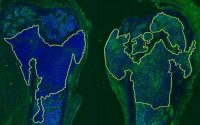Combination of two immunotherapies shows activity in non-small cell lung cancer patients
A combination of two drugs, which prompt the body’s immune system to identify and kill cancer cells, is a safe treatment for patients with advanced non-small cell lung cancer and has shown some signs of efficacy.
Results from a phase I/II clinical trial in 25 patients, presented at the 30th EORTC-NCI-AACR Symposium on Molecular Targets and Cancer Therapeutics in Dublin, Ireland, today (Thursday), identified the maximum tolerated doses at which NIR178 (PBF-509) and spartalizumab (PDR001) could be given to patients whose disease had either failed to respond or stopped responding to previous treatments. The disease shrank or disappeared in two patients and it remained stable, without progressing, in 14 patients.
Tumours are surrounded by blood vessels, normal cells and molecules that make up the tumour’s microenvironment. In order to grow and spread, tumours recruit various molecules to suppress the body’s immune system, which would otherwise recognise and kill cancer cells. Adenosine is one molecule that suppresses the immune system in the tumour microenvironment, but previous research has shown that its activity can be blocked by NIR178. Spartalizumab is a monoclonal antibody that blocks PD-1, a molecule that acts as a checkpoint to regulate the immune response.
Researchers, led by Professor Alberto Chiappori (MD) from the Moffitt Cancer Center, Tampa, USA, wanted to investigate whether the combination of these two immunotherapies might be more effective against non-small cell lung cancer than either drug on its own.
Between August 2016 and January 2018, the study enrolled 25 patients with advanced non-small cell lung cancer who had been treated already with at least one therapy and either failed to respond or relapsed. “Most of these patients were heavily pre-treated with chemotherapy, radiation and immunotherapy,” said Prof Chiappori. However, they were still fairly fit, being either fully active, with everyday life unaffected by their disease, or restricted in physically strenuous activity, but able to carry out work of a light or sedentary nature (ECOG performance status 0-1). The average age was 64, 60% were men, and 44% had received prior anti-PD-1 or PD-L1 therapy.
Spartalizumab was administered intravenously at a fixed dose of 400 mg once every four weeks. NIR178 was given orally in pill form, twice daily at escalating doses of 160 mg, 240 mg and 320 mg.
By August 2018, 23 (92%) of the patients had discontinued the treatment due to disease progression (13), death for reasons unrelated to the treatment (4), adverse side effects of the treatment (4), and withdrawal of consent to continue in the trial (2). Two patients remained on the treatment.
In 14 other patients who had not received prior anti-PD-1/L1 therapies, one (7%) experienced a complete response to the treatment, with the cancer disappearing, a second (7%) had a partial response, with the cancer shrinking, and six (43%) had stable disease. In 11 patients who had been pre-treated with anti-PD-1/L1 therapies and experienced a disease progression, eight (73%) had stable disease.
The most frequent treatment-related side effects were nausea, liver problems, fatigue and an increase in the pancreatic enzyme, lipase. Two patients suffered from severe but not life-threatening (grade 3) inflammation of lung tissues. There were no life-threatening (grade 4) treatment-related side effects.
The maximum tolerated dose was determined as 240 mg of NIR178 twice daily, and 400 mg of spartalizumab every four weeks.
“This was an early phase I/II trial of the combined treatment,” said Prof Chiappori. “We believe that observing responses in these heavily pre-treated patients is always a positive sign that represents the potential anti-tumour activity of the regimen and gives a preliminary measure of the importance of continuing to investigate it in further, more definitive studies. The regimen is already being tested in phase II trials of several other solid tumours and non-small cell lung cancer. We are also working on further understanding the mechanism of action of the combination of the two drugs in the body.”
Source: Read Full Article


